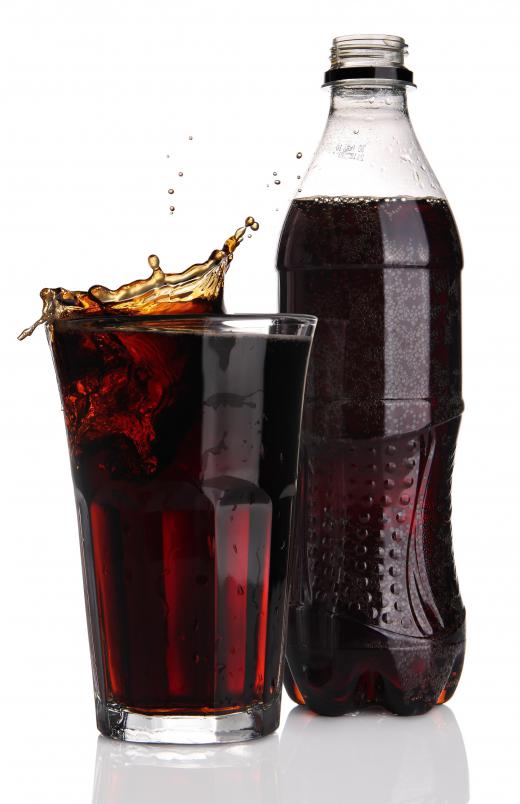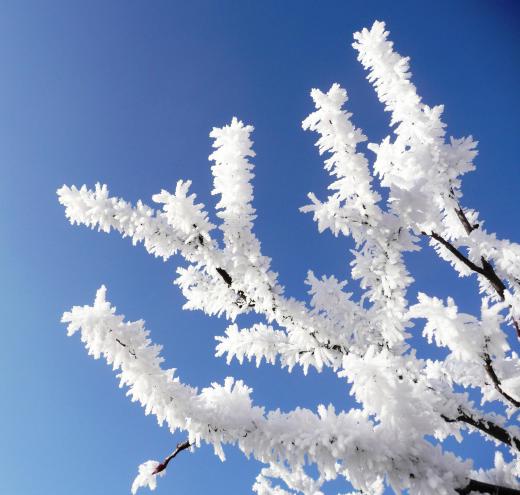What is Nucleation?
 Mary McMahon
Mary McMahon
Nucleation is a physical process in which a change of state — for example, liquid to solid — occurs in a substance around certain focal points, known as nuclei. Common examples are the condensation of water vapor into droplets in the atmosphere, the formation of ice crystals when water freezes, and the appearance of gas bubbles in a liquid. Heterogeneous nucleation happens in cases where there are pre-existing nuclei present, such as tiny dust particles suspended in a liquid or gas. Homogenous nucleation occurs where no such contaminants are present, and is much less commonly seen. This physical reaction is the basis for a variety of manufacturing processes and interesting natural phenomena.
Often, once nucleation starts to occur, it shows an exponential growth curve. For example, once crystals start to form in a solution, their surface area increases as they grow, attracting more molecules and promoting the growth at an ever-increasing rate, until the solution stabilizes and no more crystals can form. This explains why it takes time for a river to freeze over in the winter, but once the ice starts forming in the body of the river, it usually covers the river very rapidly.
Heterogeneous Nucleation

Water normally freezes at 32°F (0°C). This is because it contains numerous tiny solid particles of dust and organic matter around which freezing can occur — they can be thought of as “seeds” that start the process. Extremely pure water, which does not contain these particles, actually freezes at -43.6°F (-42°C). If pure water is cooled to a temperature below normal freezing point, but above its pure freezing point, it remains liquid, and is said to be supercooled. The water can then be induced to freeze very rapidly by adding a single small ice crystal, which acts as a nucleus.

A similar phenomenon can be demonstrated using a supersaturated solution of sodium acetate. More of the compound will dissolve in hot water than in cold, but a supersaturated solution can be made by adding it to very hot water until no more will dissolve, then allowing it to cool undisturbed. By the time the water is cold, it will have more sodium acetate in solution than could have been dissolved by simply adding it to cold water. This is a supersaturated solution. If a single grain of the compound is now added, crystals will rapidly form through nucleation and spread throughout the liquid, so that it appears to freeze.

Another entertaining example, this time involving the release of dissolved gas, is the well-known explosive demonstration using popular brands of mints and fizzy drinks. The surface of the mint is coated with sugar, which forms lots of tiny nucleation centers. The fizzy drink contains a lot of dissolved carbon dioxide, which becomes gas on contact with the mint, forming large amounts of bubbles and creating pressure that forces the liquid out of is container at high speed, forming a fountain or “geyser.”
The formation of clouds in the atmosphere is an example of a gas condensing into a liquid through nucleation. It would be much more difficult for clouds to form without the presence of dust particles in the air, which are known as condensation nuclei. It is thought that smoke, soot, and other particles produced by human activities may act in this way, increasing cloud cover in polluted areas. In some cases, tiny crystals are deliberately released into the atmosphere to act as condensation nuclei, and encourage cloud formation in very dry areas; this practice is known as “cloud seeding.”
Homogenous Nucleation
This occurs spontaneously in a substance that contains no impurities that can act as pre-existing nuclei, and is therefore completely uniform. It usually happens in response to a change in temperature or pressure. For the process to occur, new nuclei must be created out of the substance itself, through random fluctuations once conditions are suitable. An example is the freezing of absolutely pure water at -43.6°F (-42°C).
Another is the formation of ice crystals in clouds, or frozen fog at ground level. Water droplets suspended in the air can be cooled to well below freezing point without forming ice; for this reason, clouds, even when the air temperature is below freezing, usually consist of droplets of supercooled water. Freezing fog is formed from water droplets that instantly freeze when they come into contact with a surface; frozen fog, consisting of ice crystals, only forms at extremely low temperatures.
Applications
Nucleation affects, and is used in, many manufacturing processes. For example, it is employed in the production of catalysts for the chemical industry, and many catalysts achieve their effects through this process. It is also used in the manufacture of semiconductors for the electronics industry. In confectionery, the production of rock candy is an example of nucleation allowing the formation of large crystals from a supersaturated sugar solution.
AS FEATURED ON:
AS FEATURED ON:













Discussion Comments
Is there such a word as "nucleate"? Would it mean the process of nucleation or the forming of a nuclei?
What happens in the nucleation to the ice cream?
Why does heterogeneous nucleation occur without a temperature change?
Regular Coke and Mentos does produce the desired reaction. The reason most people use Diet Coke is because it is less sticky if you get sprayed.
Why does nucleation occur?
I'm sorry but i believe you have been misinformed.
I would like to know your sources for stating that the reaction between Cola and mentos only works in the diet form (unsweetened and sugar-sweetened don't work?).
I'm doing a school project on this and Cola regular and just plain water with fizz work as well.
It is true they are less explosive than the Cola light (diet) and Zero forms.
@poprock - You can replicate nucleation at home by freezing a bottle of purified water for a couple of hours -- but, don’t let it completely freeze. Take it out very carefully.
At that point, you can instantly freeze the whole bottle by either shaking it or dropping a tiny piece of ice into it, the ice would act as the ‘seed’. If you don’t know how long to freeze the bottle of purified water just put in a bottle of tap water at the same time. When the tap water freezes, then the purified water is ready.
Wow, I never thought about the process behind the Mentos mints and diet soda reaction. Are there any other at home experiments like these?
Post your comments